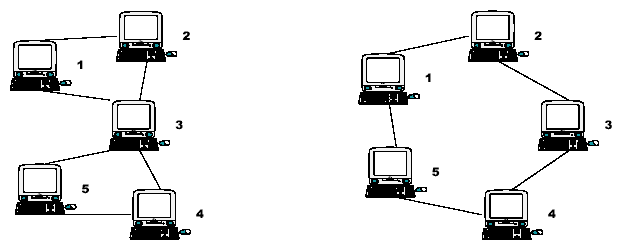poj1523 SPF 无向连通图 求割点 关节点 tarjan算法
来源:互联网 发布:overlay网络原理 编辑:程序博客网 时间:2024/05/17 03:04
SPF
Time Limit: 1000MS Memory Limit: 10000KTotal Submissions: 5103 Accepted: 2347
Description
Consider the two networks shown below. Assuming that data moves around these networks only between directly connected nodes on a peer-to-peer basis, a failure of a single node, 3, in the network on the left would prevent some of the still available nodes from communicating with each other. Nodes 1 and 2 could still communicate with each other as could nodes 4 and 5, but communication between any other pairs of nodes would no longer be possible.
Node 3 is therefore a Single Point of Failure (SPF) for this network. Strictly, an SPF will be defined as any node that, if unavailable, would prevent at least one pair of available nodes from being able to communicate on what was previously a fully connected network. Note that the network on the right has no such node; there is no SPF in the network. At least two machines must fail before there are any pairs of available nodes which cannot communicate.

Node 3 is therefore a Single Point of Failure (SPF) for this network. Strictly, an SPF will be defined as any node that, if unavailable, would prevent at least one pair of available nodes from being able to communicate on what was previously a fully connected network. Note that the network on the right has no such node; there is no SPF in the network. At least two machines must fail before there are any pairs of available nodes which cannot communicate.

Input
The input will contain the description of several networks. A network description will consist of pairs of integers, one pair per line, that identify connected nodes. Ordering of the pairs is irrelevant; 1 2 and 2 1 specify the same connection. All node numbers will range from 1 to 1000. A line containing a single zero ends the list of connected nodes. An empty network description flags the end of the input. Blank lines in the input file should be ignored.
Output
For each network in the input, you will output its number in the file, followed by a list of any SPF nodes that exist.
The first network in the file should be identified as "Network #1", the second as "Network #2", etc. For each SPF node, output a line, formatted as shown in the examples below, that identifies the node and the number of fully connected subnets that remain when that node fails. If the network has no SPF nodes, simply output the text "No SPF nodes" instead of a list of SPF nodes.
The first network in the file should be identified as "Network #1", the second as "Network #2", etc. For each SPF node, output a line, formatted as shown in the examples below, that identifies the node and the number of fully connected subnets that remain when that node fails. If the network has no SPF nodes, simply output the text "No SPF nodes" instead of a list of SPF nodes.
Sample Input
1 25 43 13 23 43 501 22 33 44 55 101 22 33 44 66 32 55 100
Sample Output
Network #1 SPF node 3 leaves 2 subnetsNetwork #2 No SPF nodesNetwork #3 SPF node 2 leaves 2 subnets SPF node 3 leaves 2 subnets
Source
Greater New York 2000
题意,就是去掉一个点和这个点连的边,图就不连通的点,其实,这个点,就是割点 关节点 。
使用tarjan算法,如果,满足dfn[v]<=low[u],那么v就是一个割点,
割点要满足两个条件,
1.如果顶点u是深度优先搜索生成树的根,则u至少有两个子女。(如果,只有1个,去掉这个点,子树就断开了)
2.如果u不是生成树的根,则它至少有一个子女 满足dfn[v]<=low[u],
#include <iostream>#include <stdio.h>#include <string.h>using namespace std;#define N 1050#define E 105000int head[N],next[E],vec[E],edge_m,n,dfn[N],low[N],clock,vis[N],son,re[N];int addedge(int a,int b){ vec[edge_m]=b;next[edge_m]=head[a];head[a]=edge_m++; vec[edge_m]=a;next[edge_m]=head[b];head[b]=edge_m++;}void init(){ memset(head,-1,sizeof(head)); memset(vis,0,sizeof(vis)); memset(re,0,sizeof(re)); son=0; edge_m=0;n=-1;clock=0;}int tarjan(int x){ dfn[x]=low[x]=clock++; vis[x]=1; int i,goal; for(i=head[x];i!=-1;i=next[i]){ goal=vec[i]; if(!vis[goal]){ tarjan(goal); low[x]=min(low[x],low[goal]); if(dfn[x]<=low[goal]){ if(x==1){son++;} else { re[x]++; } } } else { low[x]=min(low[x],dfn[goal]); } } return 1;}int main(){ int s,e,tt=1; while(scanf("%d",&s)&&s){ init(); printf("Network #%d\n",tt++); scanf("%d",&e); n=max(n,s);n=max(n,e); addedge(s,e); while(scanf("%d",&s)&&s){ scanf("%d",&e); n=max(n,s);n=max(n,e); addedge(s,e); } tarjan(1); if(son>1)re[1]=son-1; bool flag=true; for(int i=1;i<=n;i++){ if(re[i]>0){ flag=false; printf(" SPF node %d leaves %d subnets\n",i,re[i]+1); } } if(flag){ printf(" No SPF nodes\n"); } printf("\n"); } return 0;}- poj1523 SPF 无向连通图 求割点 关节点 tarjan算法
- POJ1523.SPF——无向图的割点,并求连通分支数(tarjan算法)
- [poj1523 SPF]tarjan算法求割点
- poj1523—SPF(tarjan算法求无向图中所有的割点)
- POJ1523 SPF 【求割点Tarjan】
- poj 1523 SPF 无向图关节点
- POJ1523 SPF (无向图求割点)
- [POJ1523]SPF(tarjan求割点)
- 求解无向连通图的关节点
- Tarjan 求无向图中的 关节点,和重连通分量
- POJ1523 SPF 求割点及连通块数 tarjin算法
- poj 1523 SPF(无向图求关节点)
- POJ 1523-SPF(Tarjan算法-关节点)
- POJ 1523 SPF(无向图连通分量求割点)
- poj1523--C - SPF(连通分量,求割点)
- 【连通图|关节点】POJ-1523 SPF
- 求无向图的关节点算法
- POJ 1523 SPF (无向图求割点 tarjan算法)
- 阿里C++面试经历
- 制作ext2文件系统的方法
- android中requestFocus
- Shell编程-变量
- 如何判断系统中登录用户数
- poj1523 SPF 无向连通图 求割点 关节点 tarjan算法
- HDU 4318 Power transmission
- vector中的erase方法跟algorithm的remove
- hdu4734之数位dp
- 常用的字符串处理函数
- 手机风波(二)の惊喜篇
- 红黑树
- 十万行代码
- recv send 阻塞和非阻塞


